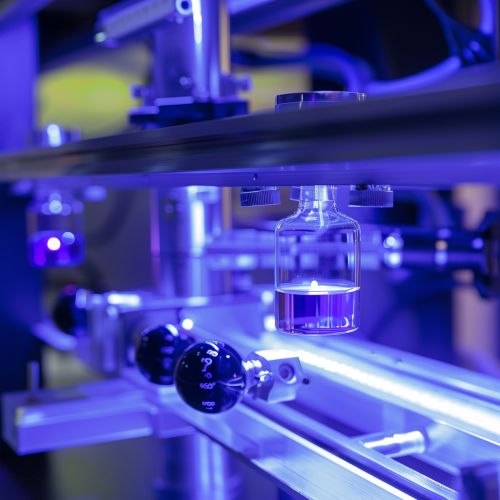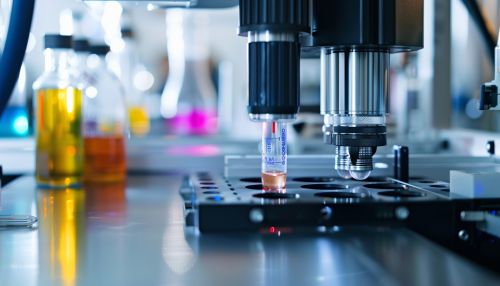Dye Laser
Introduction
A Dye Laser is a type of laser in which the active gain medium is a liquid solution of a dye. These dyes are usually organic compounds that emit light when excited by an external light source. Dye lasers are known for their tunable wavelength, which means they can produce laser light over a wide range of wavelengths, making them highly versatile in various applications.
History
The development of dye lasers began in the 1960s, with the first successful operation demonstrated by Peter Sorokin and John Lankard in 1966. The initial dyes used were rhodamine and fluorescein, which are still commonly used today. The invention of dye lasers marked a significant milestone in laser technology, providing a new tool for spectroscopy, medical applications, and scientific research.
Principles of Operation
Dye lasers operate based on the principle of stimulated emission. When the dye molecules are excited by an external light source, such as a flashlamp or another laser, they emit light at a specific wavelength. The emitted light is then amplified within the laser cavity, producing a coherent beam of laser light.
Gain Medium
The gain medium in a dye laser is typically a liquid solution of an organic dye dissolved in a solvent. Common dyes include rhodamine 6G, coumarin, and fluorescein. The choice of dye and solvent determines the laser's emission wavelength and efficiency.
Pumping Mechanism
Dye lasers require an external light source to excite the dye molecules. This is usually achieved using a flashlamp or another laser, such as a nitrogen laser or an argon-ion laser. The pumping mechanism provides the necessary energy to raise the dye molecules to an excited state, from which they can emit laser light.
Tuning Mechanism
One of the most significant advantages of dye lasers is their tunability. The emission wavelength can be adjusted by changing the dye concentration, the solvent, or the optical components within the laser cavity. A common method for tuning is to use a diffraction grating or a prism within the laser cavity, which allows for precise control over the output wavelength.
Applications
Dye lasers have a wide range of applications due to their tunable wavelength and high peak power. Some of the most notable applications include:
Spectroscopy
Dye lasers are extensively used in laser spectroscopy due to their ability to produce a wide range of wavelengths. This makes them ideal for studying the absorption and emission spectra of various materials. They are particularly useful in Raman spectroscopy and fluorescence spectroscopy.
Medical Applications
In the medical field, dye lasers are used for various therapeutic and diagnostic purposes. They are commonly used in dermatology for treating vascular lesions, such as port-wine stains and hemangiomas. The tunable wavelength allows for selective targeting of specific tissues, minimizing damage to surrounding areas.
Scientific Research
Dye lasers are valuable tools in scientific research, particularly in the fields of physics, chemistry, and biology. They are used in experiments requiring precise control over the laser wavelength, such as laser cooling and optical trapping.
Advantages and Disadvantages
Advantages
- **Tunable Wavelength:** The ability to produce laser light over a wide range of wavelengths is one of the primary advantages of dye lasers.
- **High Peak Power:** Dye lasers can generate high peak power, making them suitable for applications requiring intense laser pulses.
- **Versatility:** The wide range of available dyes and solvents allows for customization of the laser's properties to suit specific applications.
Disadvantages
- **Complexity:** Dye lasers are more complex to operate and maintain compared to solid-state lasers. The dye solution needs to be regularly replaced, and the optical components require precise alignment.
- **Cost:** The cost of dyes and solvents can be high, and the need for frequent replacement adds to the operational expenses.
- **Safety:** Handling organic dyes and solvents requires proper safety precautions, as some dyes can be toxic or carcinogenic.
Future Developments
Research in the field of dye lasers continues to advance, with ongoing efforts to improve their efficiency, stability, and ease of use. New dyes and solvents are being developed to extend the tunable range and enhance the performance of dye lasers. Additionally, advancements in solid-state dye lasers and fiber lasers are providing new opportunities for integrating dye laser technology into compact and robust systems.
See Also
- Laser
- Spectroscopy
- Solid-state laser
- Fiber laser
- Raman spectroscopy
- Fluorescence spectroscopy
- Laser cooling
- Optical trapping


